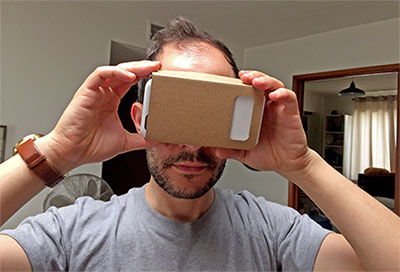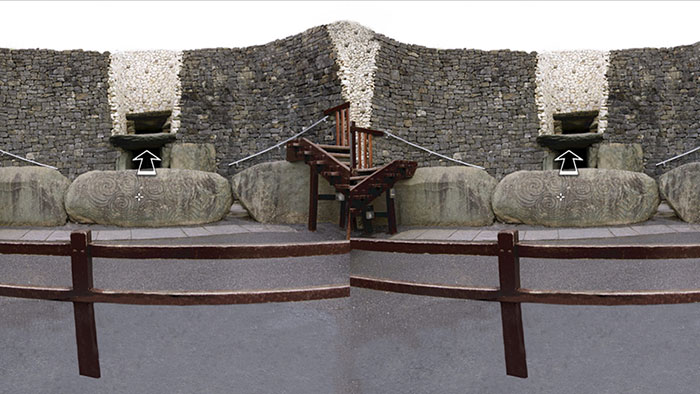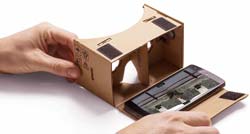17 Mar Experience Newgrange through a Head-Mounted Display
…a light began to glow and to pervade the cave, and to obliterate the stone walls and the antique hieroglyphics engraved thereon, and to melt the earthen floor into itself like a fiery sun suddenly uprisen within the world, and there was everywhere a wandering ecstasy of sound: Light and sound were one; light had a voice, and the music hung glittering in the air…
Æ (George William Russell), “A Dream of Angus Oge,” 18971

With your smartphone and Google Cardboard you can enjoy a private tour of Newgrange. Click to see the transformation.
With OPW allowing us extraordinary early-morning access to the tomb prior to its opening for the day’s crowds, we created a 10-node virtual-reality tour of the monument. Working alone for hours inside this temple built more than five millennia before that cold July morning in 2010, the words of Æ (above) reverberated in our thoughts, reminding us that this was no ordinary photo shoot; this was an opportunity to extend to those who have never visited Newgrange the verisimilitude of a sacred place.
This virtual tour, and all the research associated with it, may be found at our original Newgrange page.
The current page, however, is an experiment designed to extend the verisimilitude. We can now present the virtual tour of Newgrange using a head-mounted display (HMD). While HMD technology is still in its beta-version infancy, the acquisition of the Kickstarted Oculus Rift by Facebook in 2014 brought the attention of technologists, stock analysts, and the general public to this new frontier of mediated experience. There are now hundreds of virtual tours, 360° videos, games, and simulations available for those with the required hardware, which, for the Oculus, mandates a muscular processor and display driver.
The conventional virtual tour, as deployed throughout Voices from the Dawn, presents the user-navigable VR tours of the different sites on the screen of a computer or tablet. The user sees this as a narrow segment of his visual environment, and must stare at the screen and interact with it by using a mouse to drive a cursor. On a tablet navigation is accomplished by dragging a finger across the display.
The head-mounted display on the other hand, completely dominates the visual field of the user. It therefore isolates her from the distractions of the actual physical environment and encompasses the entire field of view, including the peripheral space, within the mediated visual experience. Navigation is immediate and intuitive; move your head and/or rotate your body to explore the 360° virtual space. Align the crosshairs target with the arrow to advance to the next scene.
The HMD Newgrange tour was originally developed and tested with the Oculus Rift. This is a rather expensive ($600 / €533) solution, but if you should happen to own one, you will be able to access the HMD Newgrange tour here, using a special beta browser called Firefox Nightly, after adding the mozVR plug-in. You can download both the browser and the plug-in here.
There are other HMD hardware solutions that are or will soon be available, such as Sony’s “Project Morpheus,” the HTC “Vive,” and the Microsoft HoloLens. These have not been tested with the Newgrange HMD tour.
In a move calculated to bring the HMD VR experience to the masses, Google introduced in 2104 a simple fold-along-the-dotted-line solution, called Google Cardboard. This is not a complete HMD, with its own twin LCD screens. With Google Cardboard, your own smartphone becomes the display screen. See the FAQ below for a list of compatible smartphones. You can download from Google a hardware list and a template that will enable you to assemble your own device from easily obtainable materials. Or you can purchase, as we did, a packaged kit with everything included, for around $15 / €14.
Once you have assembled your Google Cardboard, before inserting your smartphone, touch the image below to enter the HMD version of the Newgrange virtual tour. Then touch the “Enter VR” button. Then you can place your smartphone into your Google Cardboard and explore Newgrange. To navigate into the tomb, turn your head to align the crosshairs target with the arrow.

If you have your head-mounted display, touch the image to load the special Newgrange tour. Then touch the “Enter VR” button. To navigate, turn your head to align the crosshairs target with the arrow.
FAQ
1. Which smartphones are compatible with Google Cardboard?
2. I see two images, they are not blending together.
3. Why does my display turn off after I’ve been looking at the HMD tour for a period of time?
4. After I touch “Enter VR,” the two images on my phone are vertical, even when I rotate the phone.





